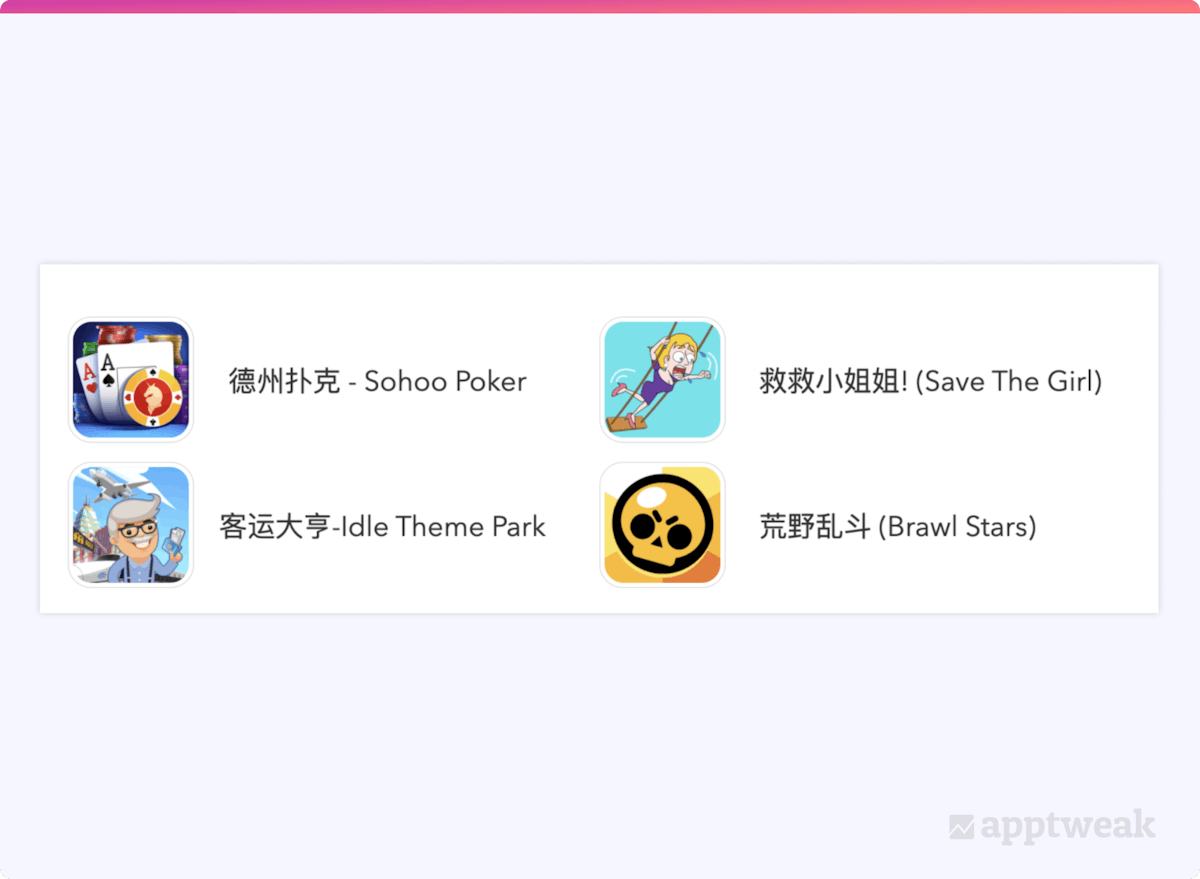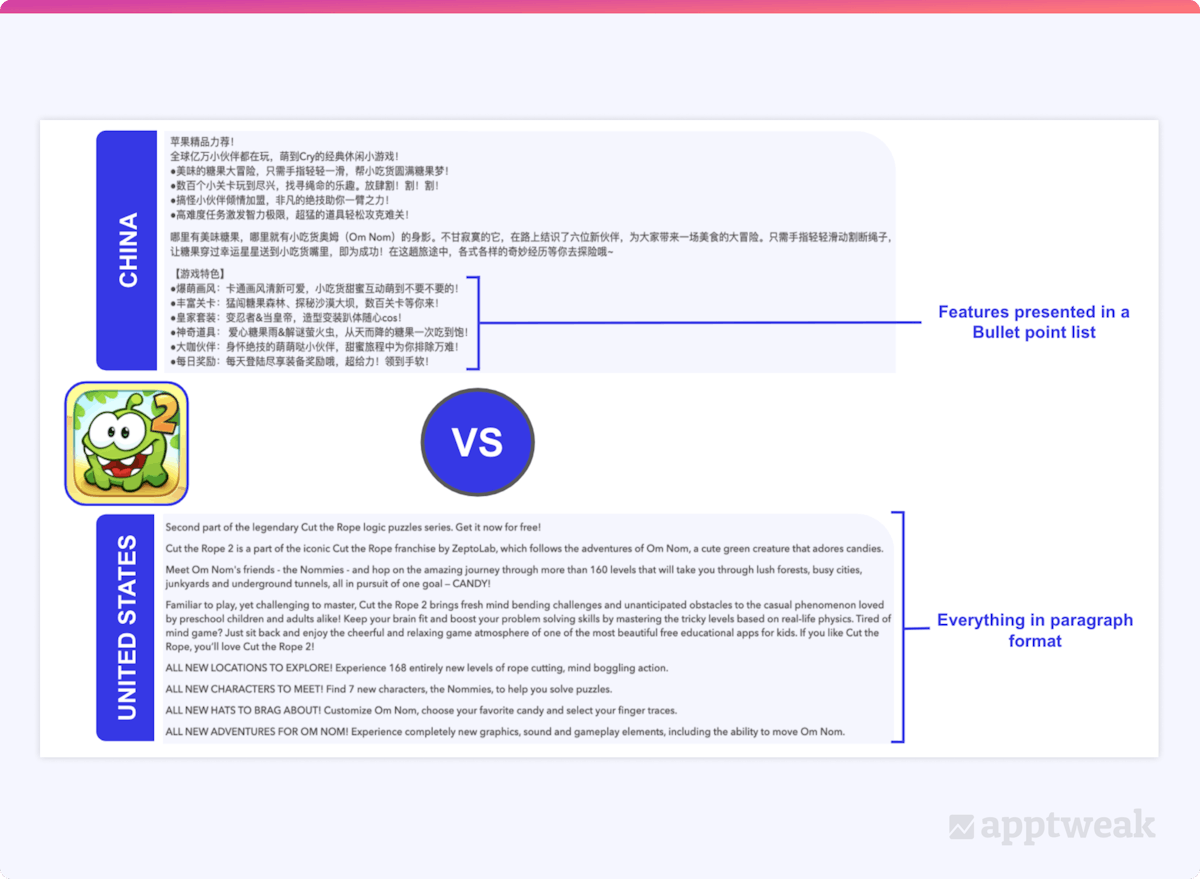
How to Localize Your App for China
China has become the world’s biggest app market, surpassing 1.1 billion app users in December 2021 (AdChina). For app developers, this makes for a huge opportunity to tap into a productive market. So, what do you need to take into account when localizing your app/game for the Chinese market? We’ve gathered for you all the information and tips you need to know to localize your app/game successfully in China.
Mobile landscape in China
iOS vs Google Play
The Chinese mobile market is very different from any other market. While the App Store is present and operational in China, Google Play is blocked, which makes it more difficult for apps/games to reach Android users. Still, Android devices dominate the local market with the number of Android users much greater than iOS. So how to make your app/game available for Android users in China?
With Google Play officially not working in China, there are over 200 local alternative Android app stores (top 20 covering almost 90% of the market). Each of these stores has its own distinctive features and tools for content promotion on its platform, so in order to localize your Android app for China, you’ll have to negotiate with each store individually. Here, we have listed the top 5 most popular Chinese app stores:
- Myapp
- 360 Mobile Assistant
- Baidu Market
- Huawei App Market
- Oppo Software Store
Despite there being more Android users than iOS users, it is still very profitable for app developers to be present on the App Store, as iOS users have a much stronger spending power than Android users in China. But even though listing an iOS app in China is pretty much the same as in other parts of the world, Western developers in China still prefer to partner with local studios to enter the market.
Top apps & games in the Chinese app market
Local apps dominate the market in China, and many Chinese users don’t like apps that look too “Western” or have very little knowledge about the latest trends outside their country. Still, that doesn’t mean Western apps don’t stand a chance. When looking at the top charts in China, we see publishers like Supercell, Voodoo, and Supersonic in the Games – Action Category and Picsart in the Photo & Video Category.
 Top 10 apps and games in the Chinese mobile app market.
Top 10 apps and games in the Chinese mobile app market.
China is a hard market to crack for app/game developers, all the more because Chinese mobile users are very particular. It is therefore very important to adapt your app to the local culture in order to make it feel like it was actually made for China. So to help you, we have listed the different elements to keep in mind when localizing your app/game into Chinese.
Language
Chinese is a very concise language that generally does not require much space. Therefore, words in Chinese consist of much less number of characters than in English (requires 30% less space). Still, Chinese characters are very complex, so it is recommended to use a larger text font in your in-app/game text.
Simplified Chinese vs Traditional Chinese
There are two different types of Chinese available to choose from on both the app stores: Simplified Chinese (zh-CN) and Traditional Chinese Taiwan (zh-TW). Whether to use one or the other depends on the region you want to target as the language spoken differs from a region to another.
- In mainland China, Singapore, and Malaysia, Simplified characters are mostly used, whereas in Hong Kong, Taiwan, and Macau, Traditional Chinese is used.
- Also, if your target users are younger, using Traditional Chinese might not be that effective because those users often dislike reading traditional characters, especially the ones in mainland China. Still, mainland users are able to read traditional characters.
Which type of Chinese to use for your app/game?
Well, as most users in mainland China prefer Simplified Chinese nowadays, we recommend defaulting your app/game to that. Still, if possible, offering the possibility in your app for users to be able to choose between the two different Chinese characters might increase your outreach and retention rate.
Finally, the Chinese like complex expressions and have different expectations when it comes to writing styles. So, it is important to use human translation to make sure your message is appropriate for the target audience.
Expert Tip
Work with a native speaker for the translation. You need to consider multiple elements in the translation process, including cultural and lingual specifics, and font selection and size.Find out which languages you should localize your app or game into
Metadata
1. Title & subtitle
- Translate your title when you enter the Chinese app market. In fact, popular international brands/games such as Angry Birds and Subway Surfers have kept their original names in all markets, except for China. However, work with a local translator, as literal translations of your title can be confusing (they don’t sound like the original English name).
- Phonetic translations don’t always resonate with your brand image, as they might have a different meaning or negative connotation. That’s why, some apps and games choose a new title that highlights the core gameplay and features that are the most appealing to the target user.
- In the App Store, we often see that international apps choose a careful phonetic translation but also add their English brand name in brackets.
 Apps and games brand names in the Chinese App Store.
Apps and games brand names in the Chinese App Store.
- Add the most relevant Chinese keywords to your app title (like in English). Make sure to select keywords that have a good volume and will drive traffic to your app. Since Apple released Apple Search Ads in China, AppTweak fetches the Apple Search Popularity score to indicate the volume of a keyword.
Learn more about the Search Popularity score and how to interpret it
Expert Tip
If you’re not too familiar with Chinese, make sure to use our Auto-Translation tool. In just a click, the suggestions will be translated to English so that you have an idea of what the keywords mean.- Finally, when adding keywords whether in the title or the subtitle, you don’t have to add indents or spaces between the hieroglyphs. Most importantly, be careful when combining hieroglyphs as some combinations might be ambiguous.
Choose your keywords with AppTweak’s AI-powered keyword list
Since 2014, AppTweak has been accumulating data on millions of search terms across the App Store and Google Play in around 100 countries. This wealth of data has sharpened our insight into the precise relationships between apps and keywords in an app store setting. Our Atlas AI can pinpoint thousands of keywords related to your app or similar ones. It then sifts through these, retaining only those with high relevance and substantial volume.
Creating such a list on AppTweak is straightforward.
Simply navigate to the Keywords tab and click the button above your keyword suggestion tabs. AppTweak will then analyze thousands of keywords, identifying those most relevant to your app with a high volume. Once ready, you’ll find your AI-generated keyword list among your other keyword lists.
The final step is to review your new list, selecting keywords with the highest potential for your app. These are the ones to incorporate into your app’s metadata, prioritizing those with the greatest relevance and volume.
Discover more about AppTweak’s AI-powered keyword list
2. Long description
Chinese mobile app users are not too keen to read long app descriptions. Instead, they prefer to watch the preview video, screenshots, and/or gameplay for the games. So keep these tips in mind when writing your long description for the Chinese app store:
- Use bullet lists rather than long paragraphs because it makes it easier and less time consuming for users to grasp what the app/game is about.
 Example of an app long description in China vs US (App Store).
Example of an app long description in China vs US (App Store).
- Highlight social proof in the app long description, such as awards received, the number of players reached, the number of levels available, and more, as these elements increase users’ trust and value perception to the game/app. In fact, Chinese users are positively influenced by these elements when deciding whether to download an app/games. So, make sure to put as many pertinent social proof elements as possible in your long description.
Creatives
When it comes to creative assets, including icons, screenshots, videos, and app previews, the Chinese have a preference for bright and cluttered creatives rather than minimalist design like in the West. Follow these useful tips to successfully localize your app/game creatives in China:
- When updating your screenshots, it is recommended to increase saturation and remove dark colors (brown, grey, etc..), especially for games.
- Make sure that your app/game creatives and the text or keywords in them align with the cultural elements and beliefs of the local market, such as having Chinese game characters or Chinese UI models. But let’s look further at some tips specific to each visual element:
1. Icon
With regard to mobile games in China’s app stores, very often the game icon reflects a game character. Even when looking at the top games in the Games (Card) category – a category that is not often associated in the West with a storyline or characters – in the Chinese market, we see that 9 out of the top 10 apps display a character in their icon.
.png?auto=format,compress&q=75&w=1200) Games in Card Category (top 10) in China vs US (App Store).
Games in Card Category (top 10) in China vs US (App Store).
- When we compare the use of characters for games in China vs the United States, we see that characters are in general more realistic or less cartoon-style in China. Designers in China use a lot of thin lines and details in their icons in comparison to the US.
.png?auto=format,compress&q=75&w=1200) Simulation Category (top 10) in China vs US (App Store).
Simulation Category (top 10) in China vs US (App Store).
- For apps, similar to the Western world, we see that apps in China often use logos or brand names in the app icon. But the Chinese branding and logos often have a different look and feel than in the Western world. For example, since brand names can sometimes be reduced to 2 or 3 characters, the logo and app icon represent the full brand name.
.png?auto=format,compress&q=75&w=1200) Shopping Category (top 10) in China vs US (App Store).
Shopping Category (top 10) in China vs US (App Store).
Another very important tip to keep in mind is that when designing your app icon, look out for the meaning of the color you use. In the Chinese culture, the colour red is associated with money and prosperity, hence most apps in the Shopping category use the colour red or a close variation of it.
2. Screenshots
Talking of screenshots for apps and games in China, here are some best practices we have observed:
- App screenshots for China tend to be cluttered, very bright (even for apps/games with a dark theme), with clear text/subtitles and links that show users all the features and functions.
- Also, the Chinese have a preference for customized text boxes in each screenshot along with a colorful and cute design less common in the Western markets. Generally, 5 or 6 screenshots are used to feature the brand image.
.png?auto=format,compress&q=75&w=1200) Create customized text boxes for screenshots with a colorful and cute design when localizing for China’s app market.
Create customized text boxes for screenshots with a colorful and cute design when localizing for China’s app market.
- For games in particular, if the content has already been localized, you should present it in your screenshots. In the case of mobile games, for example, this can be Asian characters (facial features, wardrobe, etc.) or appealing animal representations in China such as Chinese dragons and pandas. Other cultural elements such as symbols or architectures, for example, the Great Wall or the Forbidden City should be highlighted in app/game creatives and video, if any.
Bonus tips to localize your app for China
1. Colors
The color selection is crucial as colors have a clear meaning in China that is different from the West. For example, like we mentioned earlier, red represents joy and welfare and, therefore, is often used as a background color. On the other hand, white represents death and so it is better to avoid. But, in general, the Chinese tend to use bright colors and avoid low saturation.
.png?auto=format,compress&q=75&w=1200) China app market color guide for app localization.
China app market color guide for app localization.
2. QR codes
The use of QR codes is very popular in China’s mobile app market. The majority of the apps/games in China’s app stores have used them to link to promotions or to display interesting features. These can be used by integrating them into your app/game to either show users promotions and deals or to lead users to other social networking pages. For instance, China’s social network app Renren has integrated animated visual QR codes in order to entertain users and strengthen their engagement with the app.

The use of QR codes is very popular in China’s mobile app market.
3. Social sharing ability
Social sharing ability in screenshots happens to be very effective in China. Top apps in China’s app stores use some sort of social sharing ability in their screenshots to make their app visible and searchable on the web. However, many major Western social platforms are banned by the Chinese government, such as Facebook and Twitter. So keep this in mind when adding a social network to boost engagement. Some great options allowed in China to integrate social into your app/game are WeChat and Weibo, as well as the Chinese version of Twitter and Whatsapp.
4. Sensitive topics
Some topics are negatively received in China’s culture. It is recommended to avoid displaying elements such as blood, skeletons, skulls, and drugs and any bad behaviors, including sexual, drinking, gambling, and others. Politics is also a sensitive topic along with defaming the Chinese government. All these topics need to be avoided to avoid being banned from the app stores.
Apps in China tend to pop up and disappear overnight. So we recommend updating your app/game at least every 2-3 weeks. It is very important to keep your app/game continuously up-to-date in order to stay relevant in the Chinese market, as it is a fast-paced and an exigent market. In fact, apps/games that are frequently updated tend to be more relevant and drive more positive reviews from users.
Follow these tips to successfully localize your app or game in any chosen market
TLDR
The app market in China represents both a huge opportunity as well as a challenge for mobile app developers. Anyone looking to crack this market has to really understand what works in China’s app market. Here are a few tips you can follow to successfully localize your app/game in China:
- Allow users to choose between Simplified Chinese and Traditional Chinese in your app/game to increase your outreach and retention rate.
- Translate your app/game title when you enter the Chinese app market. Work with a native speaker for the translation.
- Use your most relevant Chinese keywords with a good volume in the app title.
- For long descriptions, use bullet lists rather than long paragraphs. Also, don’t forget to add social proofs like awards, etc.
- The Chinese have a preference for bright and cluttered app/game creatives with clear texts. For example, the color red is associated with joy and can positively influence users.
- Make sure that your app/game creatives and the text or keywords in them align with the cultural elements and beliefs of the local market, such as Asian characters, Chinese dragons and pandas, or the Great Wall.
- Use QR codes to offer promotion and deals when localizing your app/game for China.
- Avoid elements that have a negative connotation for the Chinese, for example, blood, skeletons, skulls, and drugs, etc.



 Ian Pernia
Ian Pernia

 Justin Duckers
Justin Duckers



